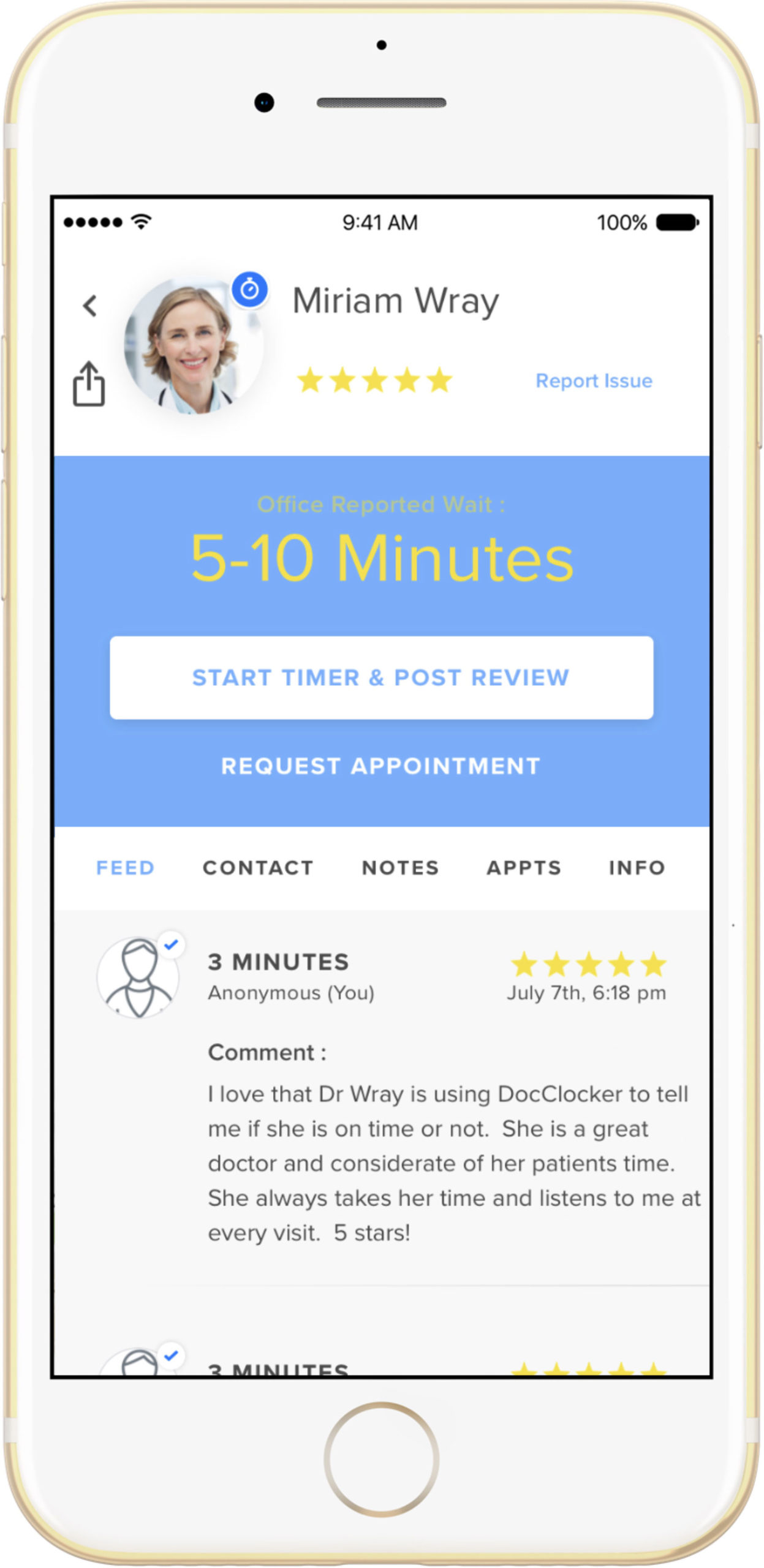TeleMed Text: Stopping COVID-19 Spread in Waiting Rooms
 An innovative app, DocClocker, for the first time enables medical facilities to provide patients with real-time wait time reporting, and is preventing the spread of COVID-19 (coronavirus) across the country by enabling patients to avoid long waits in medical waiting rooms, limiting exposure risks. The new app, financed and developed by practicing physicians, gives doctors a way to support their patients. By providing patients with real-time wait times, medical providers can help prevent the spread of the highly contagious virus by limiting the exposure of sick patients in waiting rooms.
An innovative app, DocClocker, for the first time enables medical facilities to provide patients with real-time wait time reporting, and is preventing the spread of COVID-19 (coronavirus) across the country by enabling patients to avoid long waits in medical waiting rooms, limiting exposure risks. The new app, financed and developed by practicing physicians, gives doctors a way to support their patients. By providing patients with real-time wait times, medical providers can help prevent the spread of the highly contagious virus by limiting the exposure of sick patients in waiting rooms.
“It is important that people are not sitting in sick waiting rooms during the coronavirus outbreak when there are delays in the office,” Dr. Eric Carter, Co-CEO and Co-founder of DocClocker, said in a statement. “DocClocker providers value their patients’ time and are engaged in technology efficiencies that mitigate long wait times. At times like these, patients deserve nothing less.”
The company’s mission is to create transparency in the waiting room and enhance communication between medical providers and their patients. The app easily allows medical providers to send patients who could otherwise endure long wait times updates as to when physicians are running behind so that they don’t come in until physicians are ready. Patients like it for a number of reasons: It allows patients to finish a task or project, stop along the way to get coffee or something to eat, giving that time back to the patients while protecting them at the same time. Providers who use DocClocker see more new patient bookings since they can be located and selected on the app by prospective, in-network patients. And by allowing patients to manage appointments through the app and receive appointment reminders, it also cuts down the stress at the front desk.
“As governments and communities around the globe are doing everything in their power to prevent the spread of coronavirus, it is our obligation as medical providers to do the same for the safety of our patients,” said Dr. Kevin Makati, Co-CEO and Co-Founder of DocClocker, in a statement. “By providing real-time wait times to your patients you are demonstrating your commitment and true care for their wellbeing.” And, according to numerous reviews, patients just love it.
Med Device: Possible COVID-19 Tracing App in the Works
A potential app to identify infected people and their recent person-to-person contacts is being proposed by Oxford University researchers. The team is providing the EU government with evidence that the app is feasible and not everyone needs to use it in order for it to be effective in slowing the spread of coronavirus.
Professor Christophe Fraser from Oxford University’s Big Data Institute, Nuffield Department of Medicine, explains why a contact tracing app could be widely deployed and implemented with appropriate ethical considerations. “Coronavirus is unlike previous epidemics and requires multiple inter-dependent containment strategies. Our analysis suggests that almost half of coronavirus transmissions occur in the very early phase of infection, before symptoms appear, so we need a fast and effective mobile app for alerting people who have been exposed.” He explained in a statement, “The instant mobile app concept is very simple. If you are diagnosed with coronavirus, the people you’ve recently come into contact with will be messaged advising them to isolate. If this mobile app is developed and deployed rapidly, and enough people opt-in to use such an approach, we can slow the spread of coronavirus and mitigate against devastating human, economic, and social impacts.”
As the spread of the virus spirals out of the control of health officials, the Oxford research team claims only a majority of people would need to use the app in order for it to be effective. The team is running models of the app that can include guided COVID-19 testing and targeted responses in areas with high transmission rates. The app does bring up data usage and privacy concerns, which could delay launch and discourage its use.
Patient Pages: Melanoma Rates Continue to Rise
 While many cancer rates, prostate, lung, and bladder included, have decreased over years, it is clear that melanoma rates have steadily risen since the 1970s. In fact, melanoma has risen eightfold among young women and fourfold among young men since the 70s. It is particularly prevalent for young white women. “Melanoma is increasing faster than anything else we have seen in oncology,” Jerry D. Brewer, MD, MS, a dermatologist at the Mayo Clinic in Rochester, MN told HemOnc Today. “Young white women are getting [melanoma] eight times more often now than in 1970, and although the word epidemic is overused in medicine, it would be accurate to call this rise an epidemic.”
While many cancer rates, prostate, lung, and bladder included, have decreased over years, it is clear that melanoma rates have steadily risen since the 1970s. In fact, melanoma has risen eightfold among young women and fourfold among young men since the 70s. It is particularly prevalent for young white women. “Melanoma is increasing faster than anything else we have seen in oncology,” Jerry D. Brewer, MD, MS, a dermatologist at the Mayo Clinic in Rochester, MN told HemOnc Today. “Young white women are getting [melanoma] eight times more often now than in 1970, and although the word epidemic is overused in medicine, it would be accurate to call this rise an epidemic.”
While incidences increase in the young women population, older men are more at risk for dying. Melanoma is one of only three cancers—the others being liver and esophageal cancer—for which the mortality rates are increasing among men. This difference, however, may be short lived as more women are being diagnosed with late-stage melanoma than ever before.
Why this continued increase? Research hasn’t yet pinpointed exact reasons but indoor tanning could be a large contributor. Studies on the associations between melanoma and indoor tanning find that females aged 16 to 29 years account for about 70% of tanning salon patrons. “There are other recent reports about tanning beds that suggest that if you go to a tanning bed on a regular basis your chances of melanoma are 74% higher,” Dr. Brewer also said. Sun-smart behavior and proactive trips to the dermatologist about moles and other skin issues are essential to reversing this trend.
Discoveries/Innovations: Do Supercentenarians Hold the Key to Reverse Aging?
 While it’s not known why some people live past 110, the supercentenarians as they are called, live long, healthy lives resistant to disease such as Alzheimer’s, heart disease, and cancer. For the first time, scientists have reprogrammed cells from a 114-year-old woman into induced pluripotent stem cells (iPSCs). The procedure, done by scientists at Sanford Burnham Prebys and AgeX Therapeutics, a biotechnology company, enables researchers to initiate studies that uncover the keys to their long lives and good health.
While it’s not known why some people live past 110, the supercentenarians as they are called, live long, healthy lives resistant to disease such as Alzheimer’s, heart disease, and cancer. For the first time, scientists have reprogrammed cells from a 114-year-old woman into induced pluripotent stem cells (iPSCs). The procedure, done by scientists at Sanford Burnham Prebys and AgeX Therapeutics, a biotechnology company, enables researchers to initiate studies that uncover the keys to their long lives and good health.
The study was published in Biochemical and Biophysical Research Communications, and study author Evan Y. Snyder, MD, PhD, Professor and Director of the Center for Stem Cells and Regenerative Medicine at Sanford Burnham Prebys, states, “We set out to answer a big question: Can you reprogram cells this old? But we now have a valuable tool for finding the genes and other factors that slow down the aging process.”
In the study, the scientists reprogrammed blood cells from three people including the 114-year-old woman, a healthy 43-year-old, and an 8-year-old with progeria, the condition that causes rapid aging—into iPSCs. These cells were then transformed into mesenchymal stem cells, a cell type that helps maintain and repair the body’s structural tissues such as bone, cartilage, and fat.
Researchers found that supercentenarian cells transformed as easily as the cells from the healthy and progeria samples. As expected, telomeres—protective DNA caps that shrink as we age—were also reset. Remarkably, even the telomeres of the supercentenarian iPSCs were reset to youthful levels, akin to going from age 114 to age zero. But telomere resetting in supercentenarian iPSCs occurred less frequently compared to other samples—indicating extreme aging may have some lasting effects that need to be overcome for more efficient resetting of cellular aging.
Studies can begin that determine the “secret sauce” of supercentenarians. “Why do supercentenarians age so slowly,” asks Snyder. “We are now set to answer that question in a way no one has been able to before.”
FDA Update
Drug Approvals
The FDA granted approval to Gilead’s Epclusa for treating Hepatitis C in children 6 years and up. HCV is a viral disease that causes inflammation of the liver that can compromise liver function or lead to liver failure. Epclusa is used in conjunction with ribavirin.
Rhythm Pharmaceuticals received the FDA’s Orphan Drug designation for setmelanotide to treat Alström syndrome. Alström syndrome patients may experience an insatiable hunger, also known as hyperphagia, and severe obesity beginning early in life.
Celgene, subsidiary of Bristol Myers Squibb, received approval for Zeposia as a treatment for adults with relapsing forms of multiple sclerosis. The once-a-day oral treatment reduced the annual relapse rate by 48% in year one and 38% in year two of clinical trials.
Medical Device Approvals
The FDA granted emergency authorization to Cepheid for a rapid molecular test that can detect coronavirus in 45 minutes. It is the first COVID-19 test that can be done entirely at point of care. The tests were shipped out March 30th and will continue to be produced as demand increases daily for rapid testing.
DiaSorin Inc. received approval for LIAISON XL MUREX Anti-HBs Verifiers, a lab test for detecting human antibodies against the hepatitis B virus (HBV) in a patient’s blood. The presence of antibodies can help determine if a patient has been exposed to HBV or is immune to HBV.
The FDA approved the AcrySof IQ Vivity Extended Vision Intraocular Lens series of devices by Alcon Laboratories. The IOLs are artificial lenses implanted in the eye of adult patients to correct vision after having the lens removed due to a cataract. This approval expands the use to improve how well you are able to see during close sight activities.







